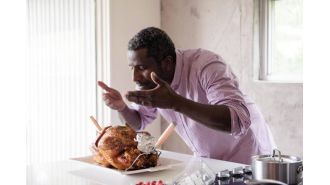You Don’t Need Invasive Tech for Successful Contact Tracing. Here’s How It Works.
While most discussions have focused on countries’ use of surveillance technology, contact tracing is actually a fairly manual process. After interviewing contact tracing experts and taking an online course, ProPublica health reporter Caroline Chen presents her takeaways.

I want you to mentally prepare yourself for a phone call that you could receive sometime over the course of this pandemic: in the next few months or year.
Your phone might ring, and when you pick it up, you may hear someone say, “Hi, I’m calling from the health department.” After verifying your identity, the person may say something like, “I’m afraid we have information that you were in close contact with someone who tested positive for the coronavirus.”
The person calling is what’s known as a contact tracer. As most states begin to lift restrictions on movement and people once more start to eat in restaurants, work in offices and get on public transit, these phone calls will become more frequent. State public health departments are hiring thousands of these workers, and experts are calling for more than 100,000 contact tracers to be deployed across America.
I can only imagine how I would feel if I got a call telling me that I had been in close contact with a COVID-19 patient — shocked, a little scared and possibly a bit in denial. But after spending a week talking to contact tracing experts across the country, and taking an online course as well, I think I’d also feel one more thing: empowered. Here’s why.
Contact tracing is a public health strategy that has been used successfully to combat infectious disease outbreaks across the globe, from the 1930s, when it helped get rampant syphilis under control in the United States, to the 2014 Ebola epidemic in West Africa.
Fundamentally, contact tracing works by tracking down all the contacts of an infected person and then taking appropriate action to break the chain of transmission. In practice, that action will vary depending on the nature of the disease — obviously, you don’t need someone to self-isolate at home and have groceries delivered to them if a disease can only be transmitted sexually.
The current coronavirus has been particularly tricky to contain because patients can be contagious a few days before they display symptoms, and some infected people may never show symptoms at all. Furthermore, the time between the onset of symptoms from one case to another is estimated to be quite short, around four days. All these characteristics have helped the virus spread rapidly — and that means that tracers have to move very quickly to reach patients and their contacts in order to cut off new branches of infection.
Experts tell me that contact tracing is the key to safely reopening the economy.
“This narrative has emerged that either we lift all our social distancing measures and let the virus burn through the population, or we hunker down at home forever and let the economy collapse, but that is a false choice,” said Dr. Crystal Watson, an assistant professor at Johns Hopkins Bloomberg School of Public Health and lead author of a white paper on how the United States can scale up its abilities to identify and trace COVID-19 cases.
“We have this tool — contact tracing — and if we spend some effort and funding on actually building up our capacities, we can control transmission, get back to work much more safely and avoid unnecessary loss of thousands of lives.”
When a patient gets a coronavirus test, the lab reports the results back not only to the patient’s doctor, but also to the local health department. A contact tracer is assigned to the case and will call the person to ask about symptoms, to take down information about people the patient has been in close contact with recently, and to help draw up a plan for isolation, which could entail figuring out how to get groceries or medications delivered.
Current guidance by the U.S. Centers for Disease Control and Prevention recommends patients who test positive isolate themselves until the following three criteria are fulfilled: 10 days have passed since symptoms first appeared, the patient has had three full days with no fever, and other symptoms like cough or shortness of breath are also improving. For close contacts who have been exposed, the CDC recommends a 14-day quarantine after the last date of exposure. (“Isolation” is the term used for confirmed positive patients, “quarantine” is used for exposed contacts; practically speaking, what you need to do is the same — stay away from others.)
A contact will be told when they were exposed, but never who it was that exposed them to the virus; the health department keeps that information anonymous.
Since the isolation period for patients with the disease depends on symptoms, health department staff need to call back regularly to monitor their progression and help determine when they can safely leave home again. They also check in on quarantined contacts, to see if they are developing symptoms and may need to get tested.
In theory, the process sounds straightforward, but the details can be daunting. I had many questions, starting with: Who exactly counts as a contact?
For now, I am still working from home and have had no prolonged or close contact with anyone other than my husband. But when New York’s stay-at-home orders end, I wanted to know: If someone in my office got sick, would my whole newsroom have to go into quarantine? What happens if someone has a subway commute — would contact tracing break down?
The CDC defines a close contact as someone who was within 6 feet of an infected person for at least 15 minutes, starting two days before the infected person began experiencing symptoms.
Public health workers will make decisions on a case by case basis, said Dr. Marcus Plescia, chief medical officer of the Association of State and Territorial Health Officials. “You don’t want too many people slipping through the cracks, but at the same time, it’s a big ask, since you’re asking people to stay at home for two weeks.”
In my hypothetical scenario, a contact tracer might consider the office’s ventilation system, Plescia said, to help decide if a whole office needed to go into quarantine. (A case study of a restaurant in Guangzhou, China, concluded that currents from an air conditioner likely helped carry the virus from an infected person to two neighboring tables.) Another factor would be how well the patient remembered all of his or her interactions in the two days before symptoms began.
When it comes to public transit, the experts told me that transmission risk would be much higher if a patient spent their whole commute chatting with a friend — in which case, they’d know who that person was and could give that information to a contact tracer — while risk would be much lower for commuters who are not touching or talking to one another, especially if everyone was wearing a mask.
Dr. Emily Gurley, an associate scientist at Johns Hopkins and instructor of a free online course now required for all tracers hired by the state of New York, noted that the CDC definition of a close contact presumes that people are not wearing masks. (And if you think you’ve got the knowledge to be a contact tracer, try our quiz.)
Still, contact tracing efforts may be hampered by other circumstances, such as when patients are too sick to interview. Then, Gurley said, “you’re trying to understand who their contacts are by talking to their family member — but they’re not going to have been with the patient all day long.”
Other times, patients may not know the names of everyone they came in contact with, such as at a gym or grocery store. In those cases, contact tracers will use whatever pieces of information they can get to track down potential contacts, according to Capt. Eric Pevzner, chief of the CDC’s Epidemic Intelligence Service program.
“You might say, ‘I talked to Bob at the grocery store, but I don’t know his last name,’ then I will call the local grocery store and ask, ‘Do you have someone called Bob who works in the produce section?’”
Pevzner recently traveled to Utah to help with contact tracing efforts. (I was surprised to hear that such a high-ranking official would be deployed to do such tedious work, but Pevzner said that the magnitude of the pandemic is so large, even he got sent into the field.)
In Utah, Pevzner made sure to always use a landline, because people wouldn’t pick up if he rang from his cellphone, presuming an out-of-state number was a spam call.
“The hard part right now is that everyone’s days are blending together, because everyone’s at home,” he said. “Normally, I could ask, ‘When did your symptoms start?’ And you might say, ‘Normally I go to spin class on Wednesday night, so it was Wednesday morning at work that I started to feel bad.’ Now, people can’t remember what day it is, so I might ask, ‘What did you watch on TV?’ And I’ll Google the TV show to figure out what day it was.”
What happens if a contact slips through the net? Much has been made of South Korea’s meticulous contact tracing abilities, which includes sweeping up citizens’ cellphone and credit card information and publishing digital diaries of positive patients — with information as granular as the seats they sat in at movie theaters and the restaurants they ate at. In Hong Kong, incoming travelers are placed in mandatory quarantine and given wristbands to track their movements to ensure compliance.
We wouldn’t do that in the United States, for both privacy and logistical reasons. Does that mean we’re doomed to contact tracing failure?
Not so, the experts told me, and there’s preliminary data that can help us estimate the levels of testing and tracing needed.
Let me first note that the following studies are preprints, which are draft research papers shared publicly before being published in an academic journal. While they are yet to be peer reviewed, outside experts not involved in the papers told me they look sound. Both papers testify to the power of contact tracing, when done robustly but not necessarily perfectly.
Researchers in the U.K. used a model to simulate the effects of various mitigation and containment strategies. The researchers estimated that isolating symptomatic cases would reduce transmission by 32%. But combining isolation with manual contact tracing of all contacts reduced transmission by 61%. If contact tracing only could track down acquaintances, but not all contacts, transmission was still reduced by 57%.
A second study, which used a model based on the Boston metropolitan area, found that so long as 50% of symptomatic infections were identified and 40% of their contacts were traced, the ensuing reduction in transmission would be sufficient to allow the reopening of the economy without overloading the health care system. The researchers picked Boston because of the quality of available data, according to senior author Yamir Moreno, a professor at the institute for biocomputation and physics of complex systems at the University of Zaragoza in Spain. “For other locations, these percentages will change, however, the fact that the best intervention is testing, contact tracing and quarantining remains,” he said.
Johns Hopkins’ Gurley reminded me: “This isn’t an all or nothing game — our goal isn’t to get rid of the virus, we missed that boat. Our goal is now to keep numbers low enough that the health care system can handle the cases and that we don’t have any large outbreaks even as we open up.”
Contact tracing can only be effective, however, if there are sufficient staff to carry it out. Local health departments have eliminated more than 50,000 jobs over the past decade, said Oscar Alleyne, chief of programs and services for the National Association of County and City Health Officials. “Those positions have not been refilled. They’ve just done more with less.”
It’s only now, in May, that states are starting to build up contact tracing forces. Estimates for how many we will need are staggering.
Wuhan, China, has a population of 11 million. At one point, it employed 9,000 contact tracers, split into 1,800 teams of five people, according to the World Health Organization-China joint mission report. That’s a ratio of 81 contact tracers per 100,000 residents. Massachusetts, which has a population of 7 million, is hiring 1,000 contact tracers, which would be about 14 contact tracers per 100,000 residents. California Gov. Gavin Newsom has said the state will recruit up to 20,000 people to do contact tracing work, including librarians and city attorney staff not able to do their current jobs. That would amount to 50 contact tracers per 100,000 residents.
Of course, the number of contact tracers needed doesn’t just depend on population, but also on the size of the outbreak and compliance with physical distancing and other mitigation measures. New Zealand, which has the virus well under control, has only 190 contact tracers for the whole country (a ratio of 4 per 100,000 residents). It’s hard to argue that they need more.
George Washington University’s Fitzhugh Mullan Institute for Health Workforce Equity has created a tool that estimates the contact tracing workforce needs by state, taking into account coronavirus case counts. As of May 7, it estimated that the United States would need about 184,000 contact tracers, or about 56 per 100,000 Americans.
Many states are still in the process of hiring. Georgia began to allow businesses to reopen on April 24, but it only announced plans to increase its contact tracing force from 250 to 1,000 workers on May 12.
New York City will hire 1,000 tracers by June 1, and it plans to hire 5,000 in total, according to NYC Health + Hospitals spokeswoman Karla Griffith. As of May 17, the city had hired “upwards of 50 people pending background checks,” she said.
“We’re still playing catch-up,” Alleyne lamented. “We’re trying to get to a place where we can move forward.”
It’s important to remember that contact tracing doesn’t work in a vacuum. States need to have robust testing capacity; without the ability to find positive cases in the first place, contact tracers can’t do their work. Once cases and contacts are identified, they also need a way to truly isolate themselves, which can be a challenge for people who share bedrooms and bathrooms with family members or roommates. Many states are now considering the use of hotels or other facilities to offer patients and contacts a place to stay if needed. This is why you often hear the phrase, “Test, trace, isolate” — “trace” on its own is not very effective. You need all three working in concert to properly cut off transmission.
And even when we have a robust contacting tracing corps in place, that doesn’t mean all physical distancing can go out the window. The U.K. modeling study assumed each case had 20 to 30 contacts. If we all started going to football games and hanging out in crowded bars, we’d massively increase the number of contacts we each had and could rapidly overwhelm the capabilities of our local health departments. In South Korea, health authorities scrambled to locate and test more than 5,000 people when a 29-year-old man tested positive after visiting five nightclubs in the capital, Seoul. Since then, more than 100 infections have been connected to the cluster — it’s unclear if all are due to this one individual — and the Seoul city government has shut down all bars and nightclubs indefinitely.
There’s more to contact tracing than suppressing transmission. Contact tracing is also a great way to gather data, which can help scientists learn about the virus.
Pevzner, of the CDC, was in Utah because he was helping to conduct a household study in which both nasal and blood samples were collected from every member of households where one person had tested positive for the coronavirus. Fourteen days later, samples were collected again. The nasal samples were used to test for an active infection, while the blood samples were used to test for antibodies, an indication of past infections. By using both types of tests, the researchers could see whether there were any family members who previously had been infected without knowing it. By testing twice over two weeks, the researchers also hoped to find out whether home isolation was successful or not, by monitoring whether any new infections developed within the household.
Dr. Adam Karpati, senior vice president of public health programs at health organization Vital Strategies, said that such studies can also help tease out “patterns of transmission,” whether that is identifying high-risk settings — are homeless shelters or certain types of workplaces particularly vulnerable? — and types of contacts that are more likely to be infected.
One question on many people’s minds is how children are affected by and transmit the coronavirus. Contact tracing studies can help to start answering that question. For example, a study of 391 COVID-19 cases and their 1,286 close contacts in Shenzhen, China, published in the journal Lancet Infectious Diseases, found that young children were as likely to get infected as adults, though the disease was far milder.
The same study found that contacts who lived with the patient or who had traveled with the patient were at higher risk of infection than other close contacts, which included people who had shared a meal or interacted socially. More studies will need to be done to confirm this type of finding — especially in different geographical and societal contexts.
Beyond traditional manual contact tracing, there’s been considerable buzz about the potential use of phone apps for contact tracing, particularly after Apple and Google announced last month that they would work together to create a contact tracing system.
The Apple-Google system uses the Bluetooth antennas in smartphones to record when two people with the same app come close to each other, but it does not log any location data. If one person later tests positive, and records that in the app, a notification will be sent to all users who were close by in recent days, without revealing the identity of the person who had tested positive. Apple and Google are not developing an app but rather a platform — the apps are to be designed by local public health authorities and run on this system.
Many of the experts I spoke to were skeptical about the success of digital contact tracing apps, because a high degree of uptake is necessary for them to be successful.
In a best-case scenario, an app could be a welcome “workforce multiplier,” helping to identify contacts and new cases at a time when speed is critical, said Watson, of Johns Hopkins, but she cautioned that if information about exposure is only shared with app users and doesn’t get shared with public health departments in a manner that allows public health workers to follow up, then utility will be limited.
Even as digital apps continue to be explored, there are other, less flashy technologies that can be helpful to contact tracing efforts. Something as simple as text messages to ask exposed contacts how they’re feeling can reduce the number of daily follow-up calls that a health worker needs to make every day.
“Let’s say you have a mild case, it may be less invasive to just text. But if you’re 75 and you say, ‘I hate texting!’ Someone should call you,” said Gurley, the instructor of the contact tracing course. “Those tech options should be there to help, not replace.”
Across all the interviews I did, there was one word that every single person I interviewed said at least once, if not multiple times: trust.
Contact tracing, ultimately, depends on the goodwill of a population. While health departments, in theory, may have some legal authority to enforce isolation of a confirmed COVID-19 patient, it’s highly unlikely in the United States that health departments could enforce a quarantine order for a contact who hasn’t yet developed symptoms, said ASTHO’s Plescia, meaning that success will be down to the voluntary cooperation of the community.
Dr. Raj Panjabi, CEO of nonprofit Last Mile Health, which works to improve access and quality of care in rural and remote communities, told me a story about contact tracing in Liberia during the Ebola outbreak. A woman in her 40s had come down with Ebola and, unable to find treatment in the city, had gone back to her home in the middle of a rainforest to be with her loved ones, where she died. A couple of weeks later, 21 people, including many who had attended her funeral, had contracted the disease.
The Ministry of Health hired people from the community and paired neighbors with nurses to go door to door to conduct interviews. Ultimately, they identified 216 contacts for the 21 cases and managed to halt transmission.
The key, Panjabi said, was “hiring the neighbors of the patients — that builds trust. You’re less likely to give your information to a stranger. You have to have rapport and empathy. It comes when someone sounds like you.”
After the Ebola outbreak, Liberia not only maintained all the health workers it had hired, but it even scaled up to create a national community health workforce of 4,000, which goes door to door providing preventive care for mothers and children, as well as testing and treatment for diseases like malaria, Panjabi said. When the coronavirus pandemic emerged, they were rapidly retrained to look out for COVID-19 cases. As of May 16, the country had reported 219 cases.
“When someone has taken the time to find you in your home village, to tell you important information about your health and to try and help you, that’s pretty compelling and that shows their commitment to you,” Johns Hopkins’ Gurley said.
Contact tracers may not have to come to my door here, in America, but I hope that if I do get called someday and am told that I was exposed to the virus, that after I get over the initial shock, I’ll have the presence of mind to say: “Thank you for all the work you’ve done to bring me this information. I’m happy to stay at home.”






